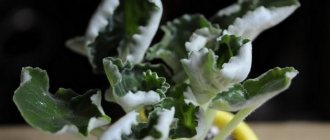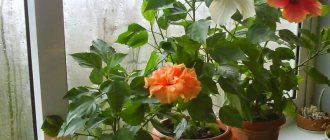Excessive "youth"
The most common phalaenopsis hybrids in home floriculture. They produce the first peduncle at the age of 1.5-3 years, when the plant already has 5-8 fully formed leaves.
In this case, the lack of flowering is not associated with any problems, you just need to wait.
If a peduncle appears on a very young orchid, it is cut off. She definitely won’t have enough strength to grow and bloom at the same time, she will seriously weaken, and may even die.
What to do if an orchid has leaves on its peduncle? Birth of a baby
After the end of flowering, a lonely flower-bearing arrow remains in the flowerpot. If it remains alive and green, without signs of drying out, then after a while dormant buds may wake up , from which the following can form:
- lateral peduncle , thanks to which the orchid will bloom again;
- small leaves that will eventually develop roots. the children (shoots) that develop - small, cavity-formed orchids.
Often they appear not only on the flower stalk, but also grow from the roots (basal children) or from buds in the leaf axils.
On the peduncle
The formation of children on the flower stalk means that even an inexperienced amateur can grow one or several independent plants without extra effort, without injuring the orchid.
This method is most convenient for vegetative propagation of orchids at home.
Baby on a peduncle.
Helpful advice! When an orchid is propagated vegetatively by children, you will receive an exact copy of the mother plant. In order for orchids to differ from each other in a number of characteristics, it is necessary to propagate it in a more complex way - using seeds.
Conditions for appearance
The most suitable period for the formation of children comes after the end of a long flowering period. The plant must have a well-developed root system and at least two pairs of large leaves.
As a rule, there are 3-4, sometimes more, dormant buds on the peduncle. In order for them to wake up, it is necessary to cut off the peduncle above one of them at a height of 2-3 cm.
Trimming the peduncles does not guarantee that the buds will wake up; after pruning, the peduncle can remain dormant for a whole year and then dry up. More often, pruning stimulates the awakening of the remaining dormant buds that are located on the flower-bearing arrow.
Sometimes children form on their own, but in some cases, even if the plant is in optimal conditions, stimulation of their forcing is necessary . This is facilitated by:
- daily temperature fluctuations. At night it should be cool - up to +17-18℃, during the day - up to +27-30℃. These conditions are most favorable in the spring and summer on a glazed balcony;
- poor watering should be combined with high relative humidity. When kept indoors, this requires regular spraying and placing the plant on a tray with damp moss or pebbles;
- a large amount of intense diffuse light.
Important! In conditions of low humidity, as well as in the autumn-winter period, when illumination drops significantly, babies are not formed.
The probability of the formation of children on flower-bearing arrows greatly increases with the use of special preparations - growth stimulants, primarily cytokinin paste.
When can you separate?
At the first stage, it is quite difficult to distinguish the baby from the side arrow on the peduncle, but as it grows, the differences will become more and more noticeable:
- The baby's leaves appear first, then the roots develop;
- 6 months after the baby appears, she already has 2 pairs of leaves.
After six months, the formed process is ready for separation. By this time, the baby should have formed 3-4 roots about 5 cm long. If the baby’s roots are too small, then the transplanted orchid will take a long time to take root and hurt. In this case, you should postpone the separation and wait for the roots to grow.
The baby can be separated when it has formed roots.
Separation technology. How to eliminate the main risks for the plant?
In order to eliminate possible risks for an adult plant, first of all, prepare the tools and related materials for work:
- disinfect garden pruners, knife or scissors;
- crush several tablets of activated carbon;
- prepare a transparent glass or flowerpot with drainage holes;
- purchase or prepare your own substrate for planting a small orchid.
The volume of the glass must correspond to the volume of the root system : the roots in it must be placed quite tightly.
The container for planting the baby should not be too large.
Separating the baby from the flower-bearing arrow is quite simple:
- when separating at the edges, the children leave up to 2 cm of the stem of the flower-bearing arrow;
- the cut is sprinkled with crushed activated carbon and allowed to dry for half an hour;
- the baby is transplanted into a separate pot with a special soil mixture and placed in a greenhouse.
After nine months, the small orchid no longer needs greenhouse conditions, and the first flowering can be expected in 2-3 years.
In the leaf axil
From the buds, which are located in the axils of the leaves, peduncles develop in some climatic conditions, and lateral shoots (babies) in others . Sometimes the plant produces several shoots at once.
A baby growing from the axil of a leaf.
Care
During the period of formation of shoots, the orchid requires ordinary care and regular watering. At this time, fertilizing is carried out with fertilizers containing a high nitrogen content, which stimulates the growth of the baby.
How long can a mother plant grow?
In order for the baby to be fully formed, it must spend about six months . Its maturity is determined by the number and length of roots.
When can you separate?
A small orchid is planted when the roots reach at least 5 cm in length and there are four to five formed leaves on the trunk . How to separate the baby from the leaf axil?
To properly separate the cuttings that have grown in the leaf axil, use pruning shears to grab another 1-1.5 cm of tissue from the mother plant, and sprinkle the cut area with crushed activated carbon.
The separated plant is planted in the prepared substrate and placed in a greenhouse (under plastic film).
Incorrect lighting
Both the lack of light and the lack of protection from direct sunlight (especially in summer, during the hottest time of day) are to blame for the lack of flowering. In the first case, the plant cannot develop normally; in the second, it gets sunburned.
For regular flowering, it needs at least 10-12 hours of daylight at any time of the year. The place for the pot is chosen so that diffused light hits the plant from the side. The window sill of an east or west window is also good.
If the plant does not have enough light in winter, it will not form a flower stalk. To ensure the required duration of daylight hours, phytolamps are used.
When does an orchid produce shoots?
An orchid can produce shoots at any time of the year. Their appearance depends not on the season, but on the conditions under which the flower is kept. Babies develop on a plant if it:
- adult;
- healthy;
- receives quality care (watering and fertilizing).
Alternatively, the baby can also grow up at the request of the grower. If you treated dormant buds with a special hormonal paste, then the formation of a sprout will definitely begin. A modern tool guarantees success in 100 percent of cases!
An orchid is a special plant, and its babies are also amazing and tender. They are easily ruined by improper care. They need a long time to develop (at least six months). They should not be touched until the roots are completely formed.
What do they look like from the photo?
What do the shoots of a tropical miracle look like? They develop gradually:
- at first they are just small tubercles on a stem or peduncle;
- then small leaves appear, after some time tiny roots grow;
- As a result, a miniature bush grows on a stem or on a peduncle, repeating the shape of an adult plant.
Attention! If the baby has not yet developed roots 5 cm long, it cannot be considered ready for independent life.
Low humidity and temperature
The orchid is originally a tropical plant. Its homeland is characterized by high air humidity (70-80%) and temperatures of 25-30°C in summer and 20-23°C in winter. A necessary condition for flowering is a difference between day and night temperatures of 5-7°C.
Since it cannot be sprayed, air humidity is increased using:
- special humidifier devices;
- “company” of other plants;
- containers with cool water placed around the room;
- strips of damp sphagnum moss wrapped around a pot or placed in a tray, coconut fiber.
In winter, the pots are moved away from radiators and other heating devices that dry out the air greatly.
Substrate of poor quality
For cultivation, a substrate is used, consisting mainly of pieces of pine bark. Other ingredients are peat chips, sand, pieces of charcoal, chopped dry sphagnum moss, fine expanded clay, even polystyrene foam.
Ordinary soil for indoor plants is not suitable for orchids due to its high moisture capacity and “oversaturation” with minerals. In such conditions, root rot develops quickly and the plant will not bloom.
To form a peduncle, it must be transplanted into a substrate of suitable quality. During the transplantation process, be sure to inspect the roots and cut out all dead tissue affected by rot.
I recommend watching the video (be sure to watch it to the end), you will learn a lot of new things:
How is it different from other parts of the plant?
Often, novice flower growers cannot determine what the orchid has produced: a root or an arrow . Indeed, only a florist with many years of experience can accurately identify the part of a plant, especially at first. But after some time, when the process reaches 1 cm in length, this will not be difficult to do.
Immediately after its appearance, the root begins to look down (stretches towards the soil and nutrients in it), and the arrow begins to look up (stretches towards the light), just like the root baby. The root is smooth, and the arrow contains "scales". The root most often grows from the neck of the plant trunk, the shoot - between the leaf plates.
We invite you to watch a video on how to distinguish the peduncle from other parts of the orchid:
Errors in watering
For normal development, and therefore flowering, of any epiphyte, proper watering is necessary. Orchids react negatively to both “drought” and “swamp” in a pot. When determining the intervals between waterings, they are guided by the condition of the substrate and roots. The first one should dry completely, the second one will develop a silver-gray “patina”.
If there are no other problems, it is enough to adjust the watering. The substrate is moistened by immersion, leaving the pot in a basin of water for 1.5-2 hours. You don’t need to pour too much, just cover the bottom third of the container. Then the excess water must be drained.
Watering is carried out exclusively with warm (40-45°C) water.
What to do to:
Has the arrow stopped developing?
In order for the arrow to grow and not slow down its growth, you need to monitor the basic parameters of care :
In order for the flowering arrow to grow well, all care conditions must be observed.
By following these rules, the plant will definitely delight its grower with beautiful tropical flowers .
Did the orchid produce several flower stalks at the same time?
How to make an orchid produce several flower stalks? will not produce more than 3 flower stalks .
More often, one shoot is produced, on which flowers bloom. But if the flower is old enough and has 8-10 leaves in the rosette, then there is a possibility of 2-3 flower stalks appearing.
But this is stress for the plant and sometimes after such abundant flowering there is a loss of strength in orchid plants. But in our conditions, which are often created even by experienced flower growers, more than 2 peduncles do not appear on flowers .
Inappropriate fertilizers or lack of fertilizing
Universal fertilizers for indoor plants, and even more so folk remedies for orchids, are strictly contraindicated. They need specialized feeding.
Phosphorus is required for the formation of flower stalks, so its presence in the composition is mandatory. With an excess of nitrogen, it “fattens”, increasing green mass, but does not bloom. She needs fertilizers with a minimum concentration of this macronutrient.
Fertilizing is combined with watering, dissolving the fertilizer in water. They are carried out no more than once every two weeks.
How did the flower shoot?
After the period of active growth of roots and leaves, the orchid enters a resting phase, during which the plant shoots out an arrow. Most often this period occurs in autumn, but in good conditions the orchid can bloom several times a year.
An orchid shoot is released from the axil of a leaf , usually the lowest one. The leaf axil is the place where the orchid leaf comes into contact with its trunk. The arrow breaks through the sheet and tends upward. The appearance of the arrow occurs under the influence of many factors: lighting, temperature, watering. If favorable conditions are not created for the orchid, then the formation and release of a peduncle will be impossible.
Root rot
Any plant with roots affected by rot will definitely not bloom. The development of rot is most often caused by regular waterlogging of the soil in combination with low indoor temperatures. The substrate in the pot becomes covered with a layer of mold and gives off an unpleasant odor.
To assess the extent of the problem, you need to remove the plant from the pot and clean the roots from the soil. Rotted tissues are black or dark brown and slimy to the touch.
They are cut off with a sharp, disinfected knife, the “wounds” are washed with a bright pink solution of any fungicide or potassium permanganate (potassium permanganate) and sprinkled with sifted wood ash, powdered activated carbon or chalk.
1.5-2 hours after the “operation” the plant is transplanted into a fresh substrate and a new pot. You can’t expect it to bloom quickly; the plant needs time to recover.
The new arrow broke
- Do not leave a broken arrow on the plant, do not glue it with tape, adhesive tape, or bandage it.
- Cut with sharp and sterile scissors 1–2 cm above the dormant bud. There is a high probability that a lateral peduncle will form from the dormant bud.
- If the peduncle breaks at the root, then you need to cut it off completely, trying to leave a small stump 1-2 cm high.
- Sprinkle the cut area with cinnamon or crushed activated carbon.
- A broken arrow can be placed in water, changing it periodically. An orchid can begin to bloom this way.
To prevent such cases from reoccurring, it is necessary to provide the plant with a habitat in which the likelihood of causing mechanical damage to the flower will be reduced to zero. Since plastic pots are quite unstable, it is advisable to place them in pots that are more stable: glass or ceramic.
Other diseases and pests
If an orchid is literally “fighting for life,” it will definitely not bloom. The list of diseases and pests typical of this plant is quite long. Therefore, you need to be able to identify the problem and know what to do in each specific case.
To notice the development of a disease or pest attack at an early stage, when it is easier to cope with the problem, it is recommended to inspect the plants once every 5-7 days.
Having discovered characteristic symptoms, the most severely affected parts of the plant are disposed of, if possible, then the “pet” is treated with a suitable chemical - a fungicide, insecticide, acaricide.
Orchids are deservedly considered delicate, capricious and demanding plants to care for. Their “fragility” and “vulnerability” requires the provision and maintenance of a specific microclimate and competent care. Otherwise, you may not expect flowering. It is also necessary to take into account the development cycle - buds will not appear at the “inopportune” time, despite all your efforts.
Care before and after the appearance of a new shoot - what is the difference?
The differences in care are best displayed in a table:
| Care before the flower stalk appears | Care after the appearance of the peduncle |
| Watering is moderate, the bark should dry out for a couple of days | Watering is reduced, spraying can destroy the shoot; wait 5 days between waterings |
| Protect the plant from drafts, but provide fresh air | Protect from draft and cold |
| Humidity is maintained at 65 – 85% | Humidity should not exceed 60% |
| Feeding is carried out with specialized preparations for orchids | Stop all fertilizing as it shortens flowering time. |
| Ambient lighting | The lack of lighting should be compensated by fluorescent lamps |
Features of care also differ depending on the time of year: for example, in the spring it is necessary to remove the plant from windows facing south to prevent burns. In winter, you should not allow the air to dry out, keep the orchid further from the radiators - at this time it is necessary to prevent the soil from drying out and organize watering more often.
If the arrow appears in winter, then you need to move the plant to a bright window in the southern part of the house. Orchids need light at least 10 hours a day; without it, the shoot may stop developing.
Video about caring for an orchid after the peduncle appears:











